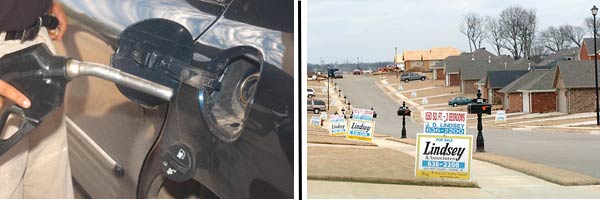 |
|||||||||||||||||
 |
|||||||||||||||||
|
||||||||||||||||||||||||||||||||||||||||||||||||||||||||||||||||||||||||||||||||||||||||||||||||||||||||||||||||||
|
|
Gas prices changing the face of America Almost overnight, gas prices have become the most pressing issue in the minds of most Americans, competing with the Iraq War and the economy at large for center stage. People are looking for solutions and grabbing the low-hanging fruit: Combine trips. Work from home occasionally. Drive the sedan instead of the SUV. Carpool. Vacation close to home. 
Most people don't expect things to get much better any time soon: A poll commissioned by SGA and other groups earlier this year showed that 92 percent believe gas will only get more expensive in the coming years. Though struggling with near-term implications, many are starting to wonder how a future of costly energy will reshape their lives and landscape. You can already see it in the housing market, where people are unable to unload McMansions in partly-finished, distant subdivisions for the same reason they can't sell their large SUVs: Potential buyers don't want the high gas bills. Americans are beginning to ask themselves the big questions: "How did we get to a situation where the only option we have is to drive? Why can't I take a train to work? Why can't my kids walk to school like I did?" Want to do something about it? Tell your Representative to help provide alternatives for high gas prices. We make it easy. Click here or on TAKE ACTION at the top left to send a message. With 95 percent of Americans lacking easy access to public transportation and untold millions living in unwalkable places, the time is now to increase our investment in strategies to lessen our need for gasoline and oil: investing in things like better public transportation, more walkable and bikeable neighborhoods, and a style of mixed, walkable development — in high demand these days — that isn't contingent on cheap gasoline. Given the situation with escalating gas prices, global warming, and our dependence on oil — regardless of the country of origin — we need better alternatives to protect us from the pain of the pump. The Wall Street Journal, CNN.com, and NPR all had excellent coverage over the last few weeks. Stay up-to-date with SGA's continuing coverage of gas prices on the SGA blog. 
Meeting the demand for smart growth is the missing link in reducing vehicle greenhouse gas emissions. After a comprehensive review of dozens of research studies, the book's authors conclude that addressing global warming without seeing a change in development trends will be nearly impossible. The positive news, however, is that meeting the growing demand for conveniently located homes in walkable neighborhoods could significantly reduce the growth in the number of miles Americans drive, shrinking the nation's carbon footprint while giving people more, and better, living options. Download the full executive summary and learn more about
smart growth, climate change, and energy security on
the study's home. You can also find a link
to order the full book from the Urban Land Institute Bookstore.
Want to dig deeper? Learn more about energy security, climate change and sustainability, and how smart growth relates to them all? Check out our Energy and Climate page.
|
|
|
HOME | WHO WE ARE | WHAT WE DO | WHAT YOU CAN DO | RESOURCES | NEWS & UPDATES | SUPPORT | CONTACT
...better choices for our communities |